A few weeks ago I wrote an article on knots. I’ve tied a few knots in my time, and I think the ones I described are all good ones. Where I went wrong was the title of the article – “The only 4 knots that you’re actually going to use in a survival situation”. You can cover most situations with those four knots, but as I said in the conclusion there are a lot more with their own uses.
This time I’m going to look at a few more of these, both ones I use a lot myself and some suggestions from readers. The first four are still a great start if you want to be prepared for anything, but adding a few more to your survival knowledge will take you a lot further when your life depends on holding things together.
Bowline
The bowline is an old sailor’s knot. If you need a secure loop at the end of a rope and don’t want to risk it slipping or binding, this is the knot you want. It’s also an intimidating knot with a reputation for being hard to tie – but in fact, it’s simple once you’ve practiced it a few times.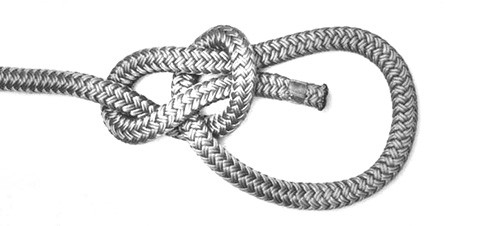 To tie a bowline, make a small loop in the rope, leaving a long enough free end to form the loop you actually want and then at least a foot more. Pass the end of the rope through the small loop, but don’t pull it tight – this is where you form the actual loop. Now pass the end round the standing part of the rope and back through the small loop. Pull the end tight to secure it. That’s you done.
To tie a bowline, make a small loop in the rope, leaving a long enough free end to form the loop you actually want and then at least a foot more. Pass the end of the rope through the small loop, but don’t pull it tight – this is where you form the actual loop. Now pass the end round the standing part of the rope and back through the small loop. Pull the end tight to secure it. That’s you done.
A bowline is very secure under load, but it can work or shake loose when it’s unloaded. That makes it easy to untie, but it also means that if your boat is pushed against its moorings by wind or tide and the load comes off the mooring lines, the bowline holding it to the post can come undone. That’s not great news when the wind changes. For security, leave a tail that’s at least twelve times as long as the rope is thick – a foot for a one-inch rope, for example. You can also use the tail to make a locking knot around either the standing end or part of the loop.
This is a very versatile knot. It’s great for securing things to posts, or two of them can be linked to join two ropes. It can also be tied with one hand. Its biggest disadvantage is that you can’t untie it when it’s under load.
Related: Did You Pass On These Skills To Your Sons When They Were Young?
Sheet Bend
You can use a bowline to join two ropes together, or the popular reef (square) knot, but if you need to join two ropes of unequal thickness the sheet bend is your first choice. Another sailor’s knot, it’s also a great one for preppers to know.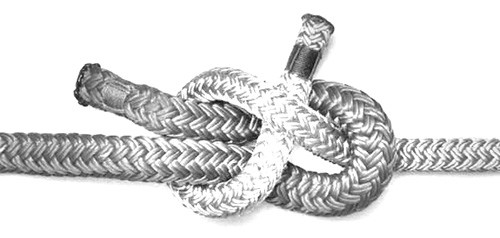 Turn the end of one rope back on itself to form a bight – if they’re unequal thicknesses, do this with the thicker one. Pass the other rope through the bight, around both parts of it, then back under itself. That’s it – done.
Turn the end of one rope back on itself to form a bight – if they’re unequal thicknesses, do this with the thicker one. Pass the other rope through the bight, around both parts of it, then back under itself. That’s it – done.
If you need more security you can make a double sheet bend by taking the smaller rope round the bight twice before passing it under itself.
The sheet bend can replace the reef knot in most situations, and is usually a better choice – but it does have one big drawback. A reef knot can be tied when there’s already a load on both ropes, as long as you can control them enough to get the ends crossed over. A sheet bend can’t be tied in a loaded rope. So if you need to lash something down tight, you have to use a reef knot.
Water Knot
What if it’s webbing straps you want to join together instead of rope? There might not seem like a big difference, but some knots really don’t work well for straps. If the strap crumples or rolls up under load, it can slip right out of the knot. Luckily there’s a great knot for this – the water knot.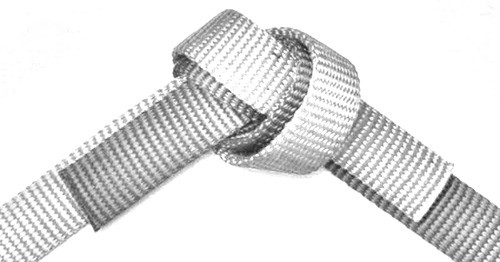 Everyone knows how to tie an overhand knot – just make a small loop, pass the end through it and pull it tight. That’s the base of the water knot. Tie an overhand knot in one strap, but leave it loose. Thread the other strap through it in the opposite direction, following the first one exactly. Then pull it tight.
Everyone knows how to tie an overhand knot – just make a small loop, pass the end through it and pull it tight. That’s the base of the water knot. Tie an overhand knot in one strap, but leave it loose. Thread the other strap through it in the opposite direction, following the first one exactly. Then pull it tight.
The water knot is strong, but has a couple of weaknesses. If the load is coming on then off again, the outer (first) strap can work loose. It can also come loose if it catches on a snag. The solution is to tie a stop knot – overhand or figure 8 – in each tail of the knot, as close to the knot itself as possible.
Related: Lost Native American Survival Skills
Prusik Knot
Do you need a loop that you can slide along a rope, but that holds firmly when a load is applied to it? You need a Prusik knot. Developed for mountaineering, it was originally used to make movable footholds on a climbing rope. It’s what’s known as a friction, or slide-and-grip, knot. There are a few of these, but the Prusik is the most versatile and probably the safest.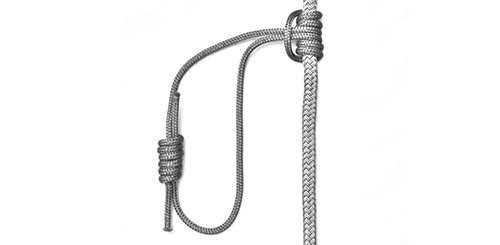 Make a piece of rope into a loop, as big as you need. Pass one end of it under the main rope. Now pass the knot end of the loop around the main rope, and through the end of itself, three times. Neaten it up so all the coils of the loop lie neatly together, then pull it tight. You now have a loop that, unloaded, can be slid along the main rope – but put tension on it and it locks down firmly.
Make a piece of rope into a loop, as big as you need. Pass one end of it under the main rope. Now pass the knot end of the loop around the main rope, and through the end of itself, three times. Neaten it up so all the coils of the loop lie neatly together, then pull it tight. You now have a loop that, unloaded, can be slid along the main rope – but put tension on it and it locks down firmly.
The Prusik works on poles, too. If you need to hoist a spar – maybe you’re improvising a sail – a Prusik knot in the centre of the spar makes a good strop for attaching a halyard to raise it with.
You may also like:
How To Install A Trip Wire Alarm On Your Property
Engineers Call This The “Solar Panel Killer” (Video)
13 Weird Survival Tools Every Prepper Should Stockpile

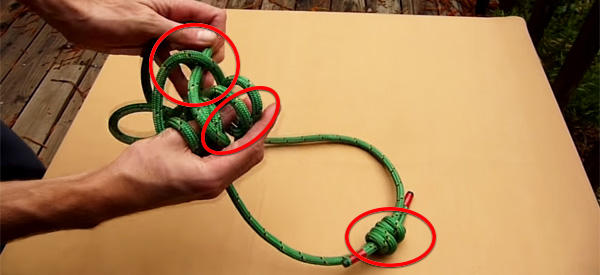














a timber hitch and inline clove hitch are knots that I use frequently. very easy to tie and once you do one you won’t forget how to tie them.
A few more knots that ive found useful, taughtline hitch, figure 8, dble figure 8, figure 9, buttefly, munter, clove hitch/ extra in line half hitch and most knots should be evaluated for the addition of an additional overhand knot at the termination of the line.
I carry a set of plastic cards like credit cards with 14 knots illustrated. I find that if I don’t use a knot frequently, I don’t remember how to tie it several months down the road when I want to use it. The card is in my small always-with-me bag which even at home is close at hand.
The set consists of six cards. It is called Pro-Knot and the website printed on the set, strangely enough is proknot.com. Haven’t checked to see if it is still up and how much the cards cost. If you are interested, you can do that yourself.
I refer to it frequently if I am tying a knot that I haven’t tied recently. That saves having to re-tie it two or three times until I get it right. Also, there is nothing quite so alarming as a knot that comes undone at a critical moment because it was tied incorrectly even though you were sure you nailed it.
Left coast chuck – Thanks for the tip about Pro-knots! I also ordered a set. I know a couple knots but not enough and these should be very helpful.
Can someone tell me how to undo the ” knot ” in my stomach? That one never seems to let go.
Relax that knot. Go to a quiet room and turn all social media off, if indeed you are cursed to have social media.Stand straight but relaxed in bare feet and loose clothes. Take slow, full, relaxed breaths through your nose while you feel your weight and balance settle on your feet. Pay attention to your jaw, it’s probably tense and maybe even clinched. Try to quiet your mind paying attention to your breathing and relax your jaw and tongue, relax around your eyes. You’ll probably lose your balance a bit, but just settle onto your feet. Now start feeling your hips and pelvis trying to relax the muscles down there, you actually have to become aware of your sphincter muscles because they are probably clinched tighter than your jaw, just breathe slowly and quietly and relax it all. Now, feel that knot in your stomach, it is no longer supported by all the other tension and should, with a bit of attention, relax. This is called centering, it takes a lot of practice but is really good for you. I do this exercise anytime I’m standing in a long line, like at the beer store on a hot day.
I never knew the name Prusik Knot but used it when young and poor to connect a climbing saddle to a rope when trimming trees. Nowhere near as efficient as rappelling gear it would still serve in an emergency for climbing or descending or as a safety harness if working above the ground.
Great info! Left Coast Chuck, I appreciate the advice on ProKnot.com. I just ordered a couple of sets of knot tying cards from them. Hopefully they will carry the Boat Knots again on the next order! I’m thinking useful Christmas presents!
BDN: You are welcome. I am always happy to provide info to fellow peppers. As the TV psa says, “The more you know.’
On second thought, maybe I should ask Proknot for a commission on my sales referrals. (; >) [Don’t know how to print the colored smiling emoji]
theres some page that lets you copy and paste the yellow emojis ? getemoji.com let me post that smiley right there, just click and drag it to the page then drag it to the text bubble.
These are some great knots. I suggest adding the Truckers Hitch to the minimal list everyone should know c